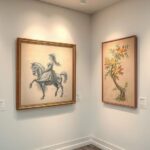Leigh Bowery was an influential performance artist and club promoter in London, merging various subcultures. His legacy is celebrated in a Tate Modern exhibition featuring his bold fashion and art, alongside photographs by renowned artists. Bowery’s work challenged societal norms and inspired designers, making him a significant figure in the creative landscape.
Leigh Bowery was a vibrant and provocative performance artist and club promoter in London, merging elements of punk, New Romantics, Goth, and more. He co-founded the Taboo club in 1985, attracting famous patrons like Boy George and George Michael, despite its brief existence of 18 months. An upcoming Tate Modern exhibition, starting on February 27, will feature his impactful fashion and performance work alongside photographs by noted artists like Nick Knight and Lucian Freud.
Known for his flamboyant costumes, Bowery’s influence spans multiple disciplines, inspiring designers like Alexander McQueen and Vivienne Westwood, although objects from these designers will not be displayed. Curator Fiontán Moran highlighted that Bowery’s significance as an artist warrants focus on his own creations, as he explored pertinent themes related to societal views on the body and club culture during a tumultuous era.
After moving to London at 19 to pursue punk fashion, Bowery’s designs included distressed fabrics showcased in New York and Tokyo. However, his dissatisfaction with mass production led him into performance art. This shift resulted in collaborations with choreographer Michael Clark, where his audacious costumes often incited controversy, including one outfit that featured a vulgar phrase.
Bowery’s performances were notorious for challenging norms, including shocking acts that led to temporary club bans. His aim was to reinvent the perception of normality, and he was dedicated to drawing connections with past creative luminaries. Sue Tilley, author of “Leigh Bowery: The Life and Times of an Icon,” described Bowery as a natural motivator whose influence extended beyond his lifetime.
His performance at the Anthony d’Offay Gallery transformed him from a personality into a recognised artist. He crafted various looks with the help of corset designer Mr. Pearl and impressed gallery director Lorcan O’Neill with his ability to captivate diverse audiences without extensive publicity. This prompted an invitation from artist Lucian Freud for portrait sessions that profoundly impacted Bowery’s life.
Bowery’s collaboration with Freud resulted in a series of portraits, and his spirited presence during sittings entertained the artist, leading to memorable interactions. His extravagant style and vibrant personality drew attention, culminating in an iconic appearance at Freud’s Metropolitan Museum show, raising Bowery’s profile significantly in the art world.
Three decades after his passing from an AIDS-related illness, Bowery’s legacy continues to shape London’s creative landscape. The Tate Modern exhibition offers a fresh look at his work and the bold ideas he represented. Both Moran and Tilley hope the exhibition will rekindle the city’s fearless approach to art and culture, reminding visitors of Bowery’s lasting impact.
Leigh Bowery, a groundbreaking figure in London’s artistic scene, influenced fashion and performance through his subversive works. His legacy is celebrated in the forthcoming Tate Modern exhibition, highlighting his innovative and provocative spirit. Both his art and life continue to inspire new generations and shape discussions on identity and culture. The exhibition aims to evoke the fearless energy of Bowery’s era, reminding us of his enduring significance in contemporary art.
Original Source: wwd.com







